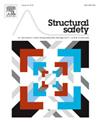多点主动学习概率密度演化方法
IF 6.3
1区 工程技术
Q1 ENGINEERING, CIVIL
引用次数: 0
摘要
概率密度演化法基于概率保持原理,可有效地应用于结构可靠度分析。尽管在过去几十年中取得了重大进展,但仍然迫切需要加强其理论基础和提高计算效率。本文提出了一种多点主动学习概率密度进化方法,该方法具有以下四个关键特征:(1)量化。将有限差分格式与Dirac序列格式相结合,提出了概率密度演化法失效概率的显式表达式。然后,量化了基于kriging的失效概率估计的认知不确定性测度。(2)减少。以封闭形式推导了一个多点学习函数,旨在选择一批新样本,以最优地减少这种认知不确定性度量。(3)最大化。多点富集过程直接基于学习函数的逐步最大化进行,消除了传统的将单点学习函数与一些额外的批量选择过程相结合的做法。(四)终止。从失效概率的认知不确定性的实际减少来检验多点富集过程的终止性。该方法在四个实例上进行了测试,并与文献中已有的几种方法进行了比较。结果表明,该方法具有较高的故障概率估计精度,在处理复杂的动态可靠性问题时,有效地节省了迭代次数和总计算时间。本文章由计算机程序翻译,如有差异,请以英文原文为准。
Multi-point active learning probability density evolution method
Probability density evolution method has been efficiently adapted for structural reliability analysis, owing to it rooting in the principle of preservation of probability. Despite achieving significant progress in the past decades, there remains a critical need to enhance its theoretical foundations and improve computational efficiency. In this paper, we develop a multi-point active learning probability density evolution method distinguished by the following four key features: (i) Quantification. An explicit formulation of failure probability is proposed for probability density evolution method by combining the finite difference scheme and the Dirac sequence scheme. Then, an epistemic uncertainty measure of Kriging-based failure probability estimation is quantified. (ii) Reduction. A multi-point learning function is deduced in closed form, aiming to select a batch of new samples to optimally reduce such epistemic uncertainty measure. (iii) Maximization. The multi-point enrichment process is directly conducted based on stepwise maximization of learning function, eliminating the traditional practice of combining a single-point learning function with some additional batch selection procedures. (iv) Termination. The termination of multi-point enrichment process is checked from the actual reduction of epistemic uncertainty of failure probability. The proposed method is tested on four examples and compared against several existing ones in the literature. The results indicate that the proposed method comes with high accuracy of failure probability estimate, whilst gaining favorable savings of the number of iterations and the total computational time, particularly when tackling with complex dynamic reliability problems.
求助全文
通过发布文献求助,成功后即可免费获取论文全文。
去求助
来源期刊

Structural Safety
工程技术-工程:土木
CiteScore
11.30
自引率
8.60%
发文量
67
审稿时长
53 days
期刊介绍:
Structural Safety is an international journal devoted to integrated risk assessment for a wide range of constructed facilities such as buildings, bridges, earth structures, offshore facilities, dams, lifelines and nuclear structural systems. Its purpose is to foster communication about risk and reliability among technical disciplines involved in design and construction, and to enhance the use of risk management in the constructed environment
 求助内容:
求助内容: 应助结果提醒方式:
应助结果提醒方式:


